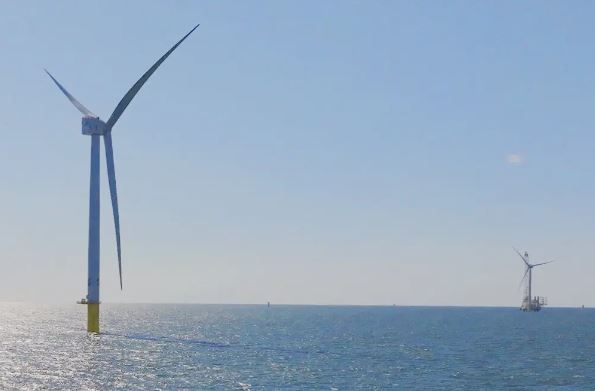In a significant milestone for the offshore wind industry, the first large-scale offshore wind farm in New England has commenced electricity generation. The Vineyard Wind project, situated off the coast of Martha’s Vineyard, Massachusetts, began delivering power on Tuesday, signaling progress in an industry that has faced various challenges over the past year.
Initially, the Vineyard Wind project can provide five megawatts of power to the grid from a single towering wind turbine. However, the project’s developers, Avangrid and Copenhagen Infrastructure Partners, have ambitious plans to install a total of 62 turbines with a capacity of 800 megawatts. This capacity is equivalent to powering approximately 400,000 homes and is scheduled for completion by the end of the year.
Vineyard Wind represents the second utility-scale offshore wind farm in the United States to begin electricity generation, following the South Fork Wind project off the coast of New York, which commenced operations in December. The South Fork Wind project is set to have a capacity of 132 megawatts.
Despite these achievements, the offshore wind industry in the United States is navigating a challenging period. Eastern states, driven by climate change concerns, aim to establish numerous large wind farms in the Atlantic Ocean to generate emission-free electricity. However, developers are grappling with rising costs, high interest rates, supply chain delays, and local opposition.
Several planned wind farms in Connecticut, Massachusetts, New Jersey, and New York have seen contracts terminated by developers, citing the impact of inflation and interest rate increases on project profitability. BloombergNEF analysts project that only 15,000 megawatts of offshore wind will be installed in the United States by 2030, about one-third less than previous expectations.
The offshore wind industry’s challenges were underscored on Wednesday when Equinor and BP announced the termination of a contract with New York for the Empire Wind 2 project. This proposed 1,260-megawatt offshore wind farm southeast of Long Island faced contract termination due to changing economic conditions, although analysts suggest the project could be rebid later.
The Biden administration has prioritized offshore wind development as part of its efforts to combat climate change and establish a new industry. However, the United States lags behind Europe, where more than 32,000 megawatts of offshore wind capacity have already been installed.
Efforts to build offshore wind turbines near Cape Cod, Massachusetts, date back to the early 2000s, with the Cape Wind project facing cancellation due to local opposition. Vineyard Wind, proposed in 2018 and approved in 2021 under the Biden administration, overcame challenges to become the first large-scale wind farm to receive federal approval. Construction commenced in June 2021.
As Vineyard Wind contributes electricity to the grid, it symbolizes progress in the U.S. offshore wind sector. The industry’s future success hinges on addressing economic challenges, securing community support, and advancing technology to meet renewable energy goals. The Biden administration’s commitment to offshore wind underscores the potential for growth, and the industry remains a focal point in the transition to cleaner, sustainable energy sources.

